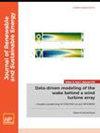Wake flow characteristics of small wind turbine models with single- and double-rotor arrangements: A wind tunnel study
IF 1.9
4区 工程技术
Q4 ENERGY & FUELS
引用次数: 0
Abstract
In the multirotor system of a wind turbine, the overall power generation is greatly influenced by the placement and interaction of rotors in proximity. Thus, a great deal of study is needed to ascertain the integration strategy of small wind turbines. In this paper, the wake flow patterns have been investigated for two model wind turbines, viz., single-rotor and double-rotor arrangements operating at a low tip speed ratio. The model rotors composed of SG6043 airfoil have a similar configuration. In the single-rotor arrangement, the model rotor is placed at the center of the wind tunnel. While in the double-rotor arrangement, the model rotors are placed at an equal distance from the central line axis of the wind tunnel. To understand the wake propagation and interaction, experiments have been performed at various wind speed conditions such that the corresponding tip speed ratio is kept between 2.5 and 3. The study is, therefore, specifically focused on the wake characteristics of the rotors under low λ, and the assessment has been made within the near wake region. The span-wise and stream-wise assessments of the wake for the double rotor suggest a minimal velocity deficit close to the rotor plane and a higher deficit downstream contrary to the single-rotor configuration.单转子和双转子布置的小型风力涡轮机模型的气流特征:风洞研究
在风力涡轮机的多旋翼系统中,旋翼的位置和相互作用对整体发电量有很大影响。因此,需要进行大量研究来确定小型风力涡轮机的集成策略。本文研究了两种风力涡轮机模型的尾流模式,即在低转速比下运行的单转子和双转子布置。由 SG6043 机翼组成的模型转子具有相似的构造。在单转子布置中,模型转子位于风洞中心。而在双旋翼布置中,模型旋翼与风洞中心线轴的距离相等。为了了解尾流的传播和相互作用,我们在不同的风速条件下进行了实验,使相应的尖端速度比保持在 2.5 和 3 之间。因此,本研究特别关注低 λ 条件下转子的尾流特性,并在近尾流区域内进行了评估。对双转子尾流的跨度和流向评估表明,与单转子结构相反,靠近转子平面的速度损失最小,而下游的速度损失较大。
本文章由计算机程序翻译,如有差异,请以英文原文为准。
求助全文
约1分钟内获得全文
求助全文
来源期刊

Journal of Renewable and Sustainable Energy
ENERGY & FUELS-ENERGY & FUELS
CiteScore
4.30
自引率
12.00%
发文量
122
审稿时长
4.2 months
期刊介绍:
The Journal of Renewable and Sustainable Energy (JRSE) is an interdisciplinary, peer-reviewed journal covering all areas of renewable and sustainable energy relevant to the physical science and engineering communities. The interdisciplinary approach of the publication ensures that the editors draw from researchers worldwide in a diverse range of fields.
Topics covered include:
Renewable energy economics and policy
Renewable energy resource assessment
Solar energy: photovoltaics, solar thermal energy, solar energy for fuels
Wind energy: wind farms, rotors and blades, on- and offshore wind conditions, aerodynamics, fluid dynamics
Bioenergy: biofuels, biomass conversion, artificial photosynthesis
Distributed energy generation: rooftop PV, distributed fuel cells, distributed wind, micro-hydrogen power generation
Power distribution & systems modeling: power electronics and controls, smart grid
Energy efficient buildings: smart windows, PV, wind, power management
Energy conversion: flexoelectric, piezoelectric, thermoelectric, other technologies
Energy storage: batteries, supercapacitors, hydrogen storage, other fuels
Fuel cells: proton exchange membrane cells, solid oxide cells, hybrid fuel cells, other
Marine and hydroelectric energy: dams, tides, waves, other
Transportation: alternative vehicle technologies, plug-in technologies, other
Geothermal energy
 求助内容:
求助内容: 应助结果提醒方式:
应助结果提醒方式:


